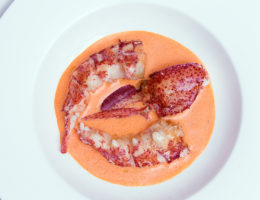The Europeans envy us our abundance of crayfish. Most of our crayfish, at least live crayfish, come from the Southeastern United States although some come from the Pacific Northwest. The Australians also have a creature they call a crayfish but it’s of a whole different family.
Despite their abundance, crayfish, a delicacy in other parts of the world, are underused except in Louisiana. This is a pity since, while they have a clear and pronounced crustacean flavor, they also have a particular flavor of their own.
Crayfish are usually sold alive although recently imported crayfish tales have become available. If you’re cooking a dish that calls only for the tails and makes no use of the rest of the body, then it makes sense to just buy the tails. But crayfish only really come into their own when you use their heads and shells to make a sauce or soup. You can also serve whole crayfish and let your guests snap off the tails.
To prepare crayfish, boil them for about 2 minutes, until they turn bright red, in a vegetable broth (court-bouillon) or in salted water containing a large bouquet garni. When crayfish are served whole, hot or cold, surrounded with their court-bouillon and its vegetables, they are said to be served à la nage. When serving them whole, encourage your guests to suck the juices out of the heads.
The procedure for making a sauce or soup is pretty much the same as when preparing a lobster. Traditional recipes call for disemboweling the crayfish while they’re still alive to remove the unsightly vein that runs along the back of the tail, but I find this too cruel and do it after the crayfish have been killed.
First, spread the crayfish over a sheet pan and sort through them to eliminate any dead ones. You may want to use a wooden spoon for the sorting since they love to bite. Never try to deal with crayfish while they’re in water as they’ll have a distinct tactical advantage. Kill the crayfish by sautéing them in olive oil for about 5 minutes. Take them out of the pan and remove the intestine by pinching the small flap at the center of the tail and giving a gentle yank. Twist off the tails. Pinch the tails between thumb and forefinger until you feel the shells crack and give. Pull away the shells.
Sweat some mirepoix in the oil use for sautéing the crayfish and add the crayfish bodies. Sauté the bodies until they turn completely red and then crush them with the end of a European-style rolling pin or the end of a cleaver. When they’re well broken up, add liquid such as wine, broth, chopped tomatoes, or water. Be sure and include some heavy cream to extract the color and flavor contained in the shells. Simmer very gently until the cream turns pink and strain through a fine-mesh strainer. If you’re being a perfectionist, you can do what the French do and finish the sauce or soup by straining it through a cloth.
The liquid used to simmer the shells is converted to a sauce or soup depending on how it’s diluted (and how much) and how or if it is thickened. A bisque will be thickened with rice or breadcrumbs, a sauce may require no thickener at all since the cream will thicken it when it reduces.
One of my favorite crayfish dishes is poulet aux écrevisses—chicken with crayfish. It is best prepared like a fricassee with the chicken very lightly browned in butter and then simmered in the liquid made from the crayfish tails. When the chicken is ready, the sauce is simply reduced to thicken it. The chicken is served with the sauce and garnished with crayfish tales.



I used to.live in a house in Cincinnati that backed up onto a golf course. The boundary between my yard and the course was a steep hill that descended from my yard and ascended again to the golf course; at the bottom ran a tiny creek. Just after moving in I climbed down the hill to explore the creek. On its muddy banks were little mounds of earth that I soon learned were crawfish chimneys. Although I once caught a crawfish, I didn’t trust the cleanliness of the water enough to try cooking it or exploring for more. So my only experience with them has been in restaurants.
Dear H.S. Gudnason,
Try buying them live from New Orleans.
jp